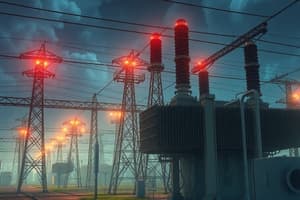Podcast
Questions and Answers
What is the primary function of a transformer?
What is the primary function of a transformer?
- To transform electric power between circuits without changing frequency (correct)
- To amplify the voltage in a circuit
- To convert electrical energy to mechanical energy
- To change the frequency of the current in a circuit
Which of the following statements is true regarding the primary and secondary windings of a transformer?
Which of the following statements is true regarding the primary and secondary windings of a transformer?
- Both windings can be connected to external loads simultaneously
- The primary winding is always of higher voltage than the secondary winding
- The secondary winding is directly connected to the AC supply
- The primary winding receives electrical energy, while the secondary winding delivers it (correct)
What principle underlies the operation of a transformer?
What principle underlies the operation of a transformer?
- Electromagnetic induction (correct)
- Resistive heating
- Static electricity generation
- Capacitive coupling between circuits
In a transformer, what happens to the current when the voltage is raised?
In a transformer, what happens to the current when the voltage is raised?
Which component in a transformer links the two coils magnetically?
Which component in a transformer links the two coils magnetically?
Flashcards
Transformer
Transformer
A device that transfers electric power from one circuit to another without changing the frequency.
Primary winding
Primary winding
The coil connected to the AC supply, where energy is fed in.
Secondary winding
Secondary winding
The coil connected to the load, from which energy is drawn out.
Mutual induction
Mutual induction
Signup and view all the flashcards
Voltage and current transformation
Voltage and current transformation
Signup and view all the flashcards
Study Notes
Transformer Fundamentals
- Transformers are static devices that convert electrical power in one circuit to power of the same frequency in another circuit.
- They change voltage and current proportionally: increasing voltage decreases current, and vice versa.
- The core principle is mutual induction between linked circuits, creating a common magnetic flux.
- A basic transformer has two electrically-separated but magnetically-linked coils.
- The coils have high mutual inductance.
- An alternating current in the primary coil creates a changing magnetic flux in the laminated core.
- This flux induces a voltage in the secondary coil (Faraday's Law).
- Closing the secondary circuit allows current flow, transferring energy through magnetic induction.
- The primary coil receives power from the AC source.
- The secondary coil delivers the transformed power.
Studying That Suits You
Use AI to generate personalized quizzes and flashcards to suit your learning preferences.




